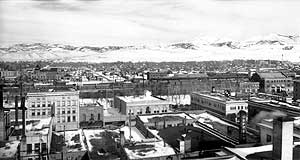|
Page
125
|
 Downtown
Pocatello, looking southeast from the Bannock Hotel in early 1934 or 1935.
The Center Street Subway is in use; it was dedicated in January, 1934.
The white building in the left middle, on the east side of Main Street,
is the Hotel Nicollet, later renamed the Hotel Whitman, which still operates.
On the extreme left is the rear of the Kane Building. The Ford Pool Hall
is south of the Whitman Hotel. The Kress Building is relatively new. The
Block Building (now the Brokerage) at the corner of West Lewis and South
Main was not constructed. The Fargo-Wilson-Wells Department Store (F.W.W.)
occupies what is now Station Square. Kiddy corner from this was the Capitol
Theater. The Yellowstone Hotel stands at the corner of Main and Bonneville.
Across Main Street from Fargo's is the Hotel Benson and south of it is
the Montgomery Ward store. The chimney in the right foreground is on the
Federal Building at the corner of South Arthur and West Lewis. Note weather
station on right. A parking lot now occupies the site of the Orpheum Theater.
Downtown
Pocatello, looking southeast from the Bannock Hotel in early 1934 or 1935.
The Center Street Subway is in use; it was dedicated in January, 1934.
The white building in the left middle, on the east side of Main Street,
is the Hotel Nicollet, later renamed the Hotel Whitman, which still operates.
On the extreme left is the rear of the Kane Building. The Ford Pool Hall
is south of the Whitman Hotel. The Kress Building is relatively new. The
Block Building (now the Brokerage) at the corner of West Lewis and South
Main was not constructed. The Fargo-Wilson-Wells Department Store (F.W.W.)
occupies what is now Station Square. Kiddy corner from this was the Capitol
Theater. The Yellowstone Hotel stands at the corner of Main and Bonneville.
Across Main Street from Fargo's is the Hotel Benson and south of it is
the Montgomery Ward store. The chimney in the right foreground is on the
Federal Building at the corner of South Arthur and West Lewis. Note weather
station on right. A parking lot now occupies the site of the Orpheum Theater.
The Oregon Short Line Depot, built in 1915, stands as a monument to the importance of the railroad to the city. Across the tracks on the roof of a long railroad freight dock is the name Pocatello, a north arrow, and an indication of the direction to the airport, five miles away. Such "roof-art" was required in the 1930s to help early pilots find where they were, and show the direction to the airport.
Beyond the railway on the left side of the view are the Phoenix Building and the Porters and Waiters Hotel. Across Center Street is a "Bee Hive" sign, on a building later used for the Pocatello City Offices and Block's Department Store. The Keystone Hotel is east of it. The Auditorium Theater (with broad peaked roof) is south of Center and across from the Keystone. The sharp peaked roof beyond it is the Pocatello House Hotel at east Center and 2nd Avenue.
In the right distance are the University of Idaho, Southern Branch, Red Hill with small quarry, and on the skyline, Chinks Peak, named for Chinese miners after the turn of the century.
Photograph by Cook Photography, Bannock County Historical Society Collection.